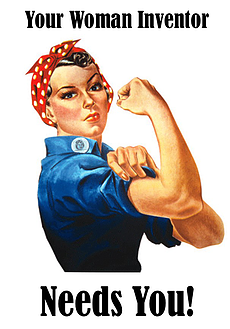In many business competitions out of ten people short-listed, there is just one woman- frequently out of over 1000 applicants to the competition. What is going wrong here? Why is it that business ideas presented by women are not chosen as winners?

There are many examples of discrimination of females. like in the workplace (the wage gap, the glass ceiling effect), in relations, law and education. Even in the place, you would expect it the least, science. There are shocking examples of women that did not get the credits they deserved.
Take Rosalind Frankfurt (1920-1958). She was the most important person in the story of DNA’s discovery, but she never was nominated for a Nobel prize. Only thirty years later, in 1998, the National Portrait Gallery in London added Rosalind Franklin’s portrait next to her former colleagues Francis Crick, James Watson and Maurice Wilkins. After her death in 1962, they had won the Nobel prize for discovering the helix structure of the DNA molecule.
As of 2015, Nobel Prizes have been awarded to 822 men and 48 women.
In 1952, the Boston Symphony was looking to diversify it’s male-dominated orchestra, so it conducted an experiment with a series of blind auditions. For the auditions, the musicians would be playing behind a screen, in an effort to remove all chance of bias and allow for a merit-based selection only – a selection that would hopefully increase the number of women in the orchestra.

Then they asked the musicians to take off their shoes. The reason? The sound of the women’s heels as they entered the audition unknowingly influenced the adjudicators. Once the musicians removed their shoes, almost 50% of the women made it past the first audition. The moral of the story? Overcoming unconscious bias isn’t as easy as one might think
Apparently, the same discrimination takes place in awarding innovation prizes. We asked Google about sex discrimination in awarding innovation prizes, but we got only broad hits on sex discrimination in general. So, now we could be definitely sure that sex discrimination regarding innovation exists.
What could be causes, and better, what could be done if we assume that creative thinking, persistence and business qualities are equally distributed among women and men?
First. let us put a few things straight. Overall there are fewer female innovators so statistically you would expect fewer female innovators being shortlisted in competitions. A problem is that many companies fail to realize the innovative potential of women. In addition, companies often lack the knowledge and understanding to endorse their suggestions. Being creative and suggesting new ideas and improvement is never easy. Yet it seems like women are having even more problems. The board of many companies consists of men and this means that it is extra hard for women to receive attention for their ideas. To complicate things further female innovators tend to focus on other areas as compared to men, their innovations are often not in the tech area which is sometimes regarded as highly desirable both by many companies and society.
Women are often making an impact in social innovations, for example, ideas about products that can improve the lives of women and girls
we are bold. we are dreamers. we are innovators. we are a movement of female change agents and thought leader who dare to change the world. Girltank
So what can be done to ensure that ideas are judged based upon their value rather than being evaluated based upon the name and the gender of the person or team who is putting forward a certain idea?
- Often women are asked to pitch and present their ideas to men. A simply way to overcome this problem is to make sure that the sexes are equally represented.
There is a tendency to believe in the power of experts, yet, people who are successful innovators are not necessarily the best judges. To be a good judge of the value and potential of an innovation or idea, you need to a certain extent follow the rules. What are the rules?
- The criteria for a great idea varies depending upon the topic. It is fundamental to ensure that the criteria are not biased, yet, this may not be as easy as it sounds. Nevertheless, the first step is to spend time thinking about the criteria as well as the process.
The Electrolux competition, focuses on providing time for the participants to develop their initial concepts. They are provided with feedback. This approach highlights the an idea is not a finished product rather it is a starting point.
In contrast, the Biomimiciry challenge requires for rather elaborated idea before even entering the contest.
Criterion Open Category Student Category
Biomimicry Process 20% 25%
Context and Relevance 20% 20%
Social and Environmental Benefits 15% 15%
Feasibility 15% 10%
Creativity 10% 10%
Communication and Presentation 10% 10%
Team 10% 10%
Other important aspects to determine the value, potential and risks with an invention are: problem definition, customer definition, product definition, potential for social impact, and sustainability. The Edison Awards judging criteria highlights the importance of an invention that “seize an opportunity and create a new market or industry”.
- Provide several different categories to ensure that a wide range of products are receiving attention. This approach may prevent an improvement for a baby to be judged in the same category as a app for a new way of shopping online.

To conclude, a jury must not only consist of men. Also, a jury should be obliged to search actively for as much values the idea delivers to different categories of people.
After all, an innovation is an new idea that creates value. By focusing on value we may avoid the “Very Good, Though Female” trap.
More about values and innovation in value engineering and thinking about value
